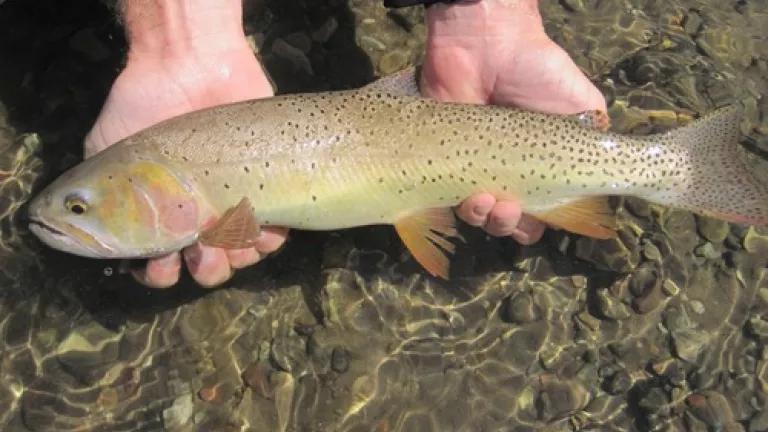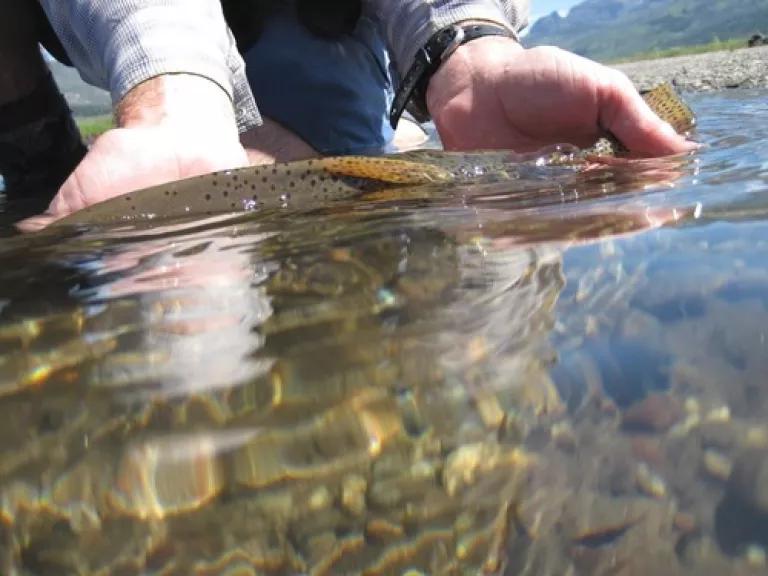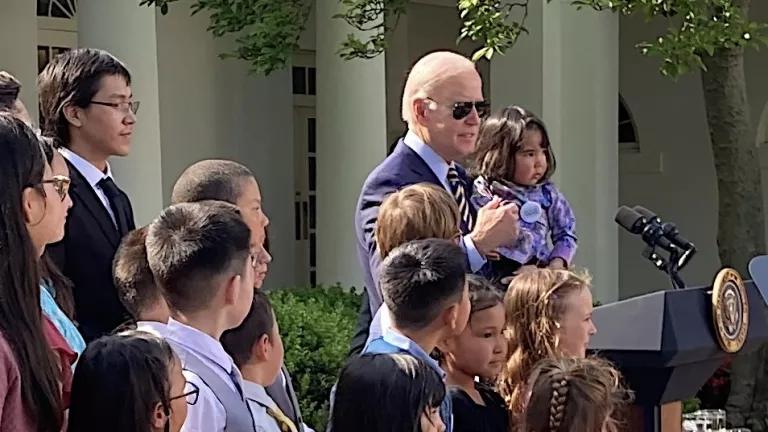
A brook trout in New England is a vastly different fish from a brook trout in the West. Genetically identical, same spots on its flanks, still heartbreakingly beautiful, but a brookie in the West is a fish out of water, if you will.
That’s because brook trout are native to the East. Saunter up a babbling brook that cascades down through a lush, dense forest in the gentle Green Mountains of Vermont – brook trout country. Slither through some sagebrush alongside a fast-flowing freestone river framed by snow-covered 11,000-foot peaks in June in southwest Montana – not brook trout country.
What happened? Simple: some “bucket biologists” with genuinely good intentions – both government-sponsored and independent – stocked rivers around the country with reckless abandon in the late nineteenth century and much of the twentieth.
Those big brown trout in the Yellowstone River? They, like soccer and small bathrooms, are native to Europe. And the fittingly named rainbow trout? Native to the rivers of the Pacific coast.
The thinking was: trout are good, so more trout must be better. Rivers were supplemented, fishless streams were amended, and our nation’s waterways would never be the same.
Today, some of our native fish species are paying dearly for our misguided efforts of yesteryear, none more so than the Yellowstone cutthroat trout.
Yellowstone cutts, as their name implies, are native to the Greater Yellowstone Ecosystem. They are gorgeous fish, with an orange slash along the bottom of each gill plate (hence “cut throat”), rounded heads, and, what has always looked like to me, a friendly face.
Historically, their stronghold has been Yellowstone Lake, the largest lake at high elevation (i.e., more than 7,000 feet) in North America, and its many tributaries.
But thanks to non-native lake trout that were illegally stocked a few decades ago, the Yellowstone cutthroat population in Yellowstone Lake has plummeted in recent years due to predation by the lake trout, which is bad for grizzly bears, eagles, ospreys, otters, and the long-term future of Yellowstone cutts.
Adding fuel to the fire, Yellowstone cutthroat trout in rivers and streams away from Yellowstone Lake, including such fabled waters as Slough Creek and the Lamar River, are threatened by competition from non-native trout (i.e., rainbows, browns, and brookies) as well as hybridization from rainbow trout, as both Yellowstone cutts and rainbows are spring spawners.
(Oh, and there’s also this little fella named Climate Change, but let’s not go there today.)
Fortunately, Yellowstone National Park and the National Park Service have recognized the seriousness of the situation, and they recently released a Native Fish Conservation Plan, which sets out a more aggressive strategy to deal with this calamity.
And the plan is not limited to Yellowstone cutthroat trout. It encompasses protection efforts for two other severely imperiled native fish: river-dwelling Arctic grayling, which are now completely gone from all park waters, and westslope cutthroat trout, which now exist in only two small creeks.
According to the plan’s environmental assessment, “Of the approximately 644 km of river habitat that originally supported native fish when the park was established, only 50 km still have native fish that are genetically unaltered, while approximately 736 km currently support non-native and/or hybridized (genetically altered) trout.”
Clearly, the time for action is now.
The park’s conservation plan will involve various methods and projects, with the highest native fish conservation priority being the restoration of Yellowstone cutthroat trout in Yellowstone Lake. To accomplish this worthy goal, the park will, among other things, ramp up its netting of non-native lake trout for the next several years.
Additionally, the plan prescribes for removing non-native fish from certain streams, rivers and lakes in the park, creating artificial barriers or modifying existing natural features (i.e., small waterfalls) to prevent upstream movement of non-native fish, and then restocking such waters with genetically unaltered native fish (i.e., Yellowstone cutts, westslope cutts, Arctic grayling). No changes have been proposed for the Madison or Firehole Rivers.
The park will begin implementing its native fish plan this summer, and the timing could not be better, as native trout (and salmon) continue to face more and more threats across the country these days. Habitat loss, climate change, hybridization, predation and competition from non-native fish; listing the myriad of threats gives me a headache.
But in Yellowstone, the country's first national park, the park service is about to roll up its sleeves and get to work protecting and restoring native fish in the park. For that, I am grateful.
I look forward to hiking into the backcountry meadows of Slough Creek in Yellowstone with a fly rod this summer. I look forward to catching and releasing several plump Yellowstone cutts. I look forward to my knees getting weak at the sight of those beautiful fish.
And in fifty years, thanks to the park’s bold new plan, I look forward to our grandkids doing the exact same thing.

This article originally appeared in The Bozeman Magpie.



